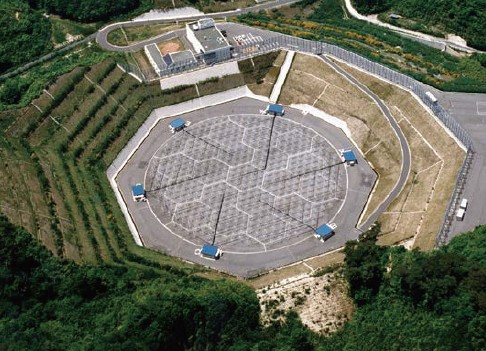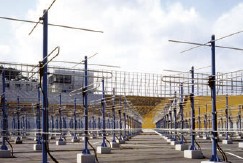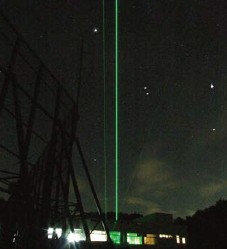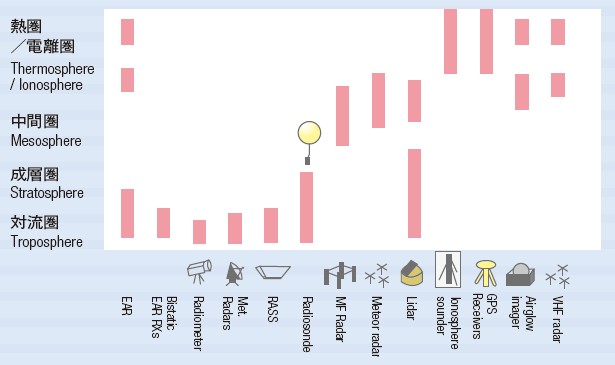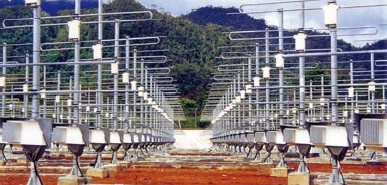MU Radar and Shigaraki MU Observatory/Equatorial Atmosphere Radar
Updated: 2022/04/12
MU Radar and Shigaraki MU Observatory
The MU radar, located at the Shigaraki MU Observatory in Shigaraki, Japan, is known as the most capable atmospheric radar in the world. It has been used by both domestic and international researchers since 1984 to study variability of the Earth’s atmosphere from a variety of perspectives, including meteorology and upper atmosphere dynamics. The MU radar, which is the first large-scale MST radar with a two-dimensional active phased array antenna system, was selected for an IEEE Milestone, an award that honors significant technical achievement in all areas associated with IEEE. Previous milestones include the Yagi-Uda antenna and the Tokaido Shinkansen. The dedication commemorative ceremony was held in May, 2015.
MU Radar
The MU radar uses VHF radio waves with a frequency of 46.5 MHz (1 MW peak output power). The antenna area consists of 475 Yagi antennas arranged in a 103 m diameter circular array. Fast beam steering and flexibility for various observational configurations characterize the instrument. In 2004, an imaging observation system with ultra multi-channel digital receivers was installed for the study of detailed atmospheric structures.
Various Instruments at the Shigaraki MU Observatory
The novel techniques used by the MU radar have been applied to the development of various other types of atmospheric radar systems. Many of these and other instruments are operated at the Shigaraki MU Observatory, which has become a core center of atmospheric observations. In 2017, the MU radar high sensitivity observation system was installed for improving receiving sensitivity.
Equatorial Atmosphere Radar
The EAR is a large Doppler radar facility located in West Sumatra, Indonesia. It consists of 560 Yagi antennas in a 110 m diameter circular field. The EAR has similar functionality as the MU radar except that its output power is 100 kW. It can observe winds and turbulence in the altitude range of 1.5 to 20 km (troposphere and lower-stratosphere), as well as ionospheric irregularities at an altitude above 90 km. In close collaboration with the National Institute for Aeronautics and Space (LAPAN) of Indonesia, EAR has carried out long-term observations since June 2001. Collaborative studies with Nagoya University, Tokyo Metropolitan University, Shimane University, National Institute of Information and Communications Technology (NICT), Electronic Navigation Research Institute (ENRI) and among others, were conducted. These collaborations have resulted in various technical advances at the EAR site.
Cumulonimbus convection is active in the equatorial atmosphere. It generates atmospheric waves that propagate to transport energy and momentum into the upper atmosphere, including ionosphere. Different atmospheric minor constituents originating at low- and middle-latitude regions also converge at the equatorial region, where they are blown upward through the tropopause and reach the middle atmosphere to spread globally. Plasma disturbances occur in the upper atmosphere, while the equatorial ionization anomaly (EIA) is also generated around the equator. Using radar systems and other instruments, we capture and study the energy and material flows, known as the Equatorial Fountain, at all heights of the equatorial atmosphere. Furthermore, we propose to build the Equatorial MU (EMU) radar, a facility ten times more sensitive than the EAR. The study of the Equatorial Fountain and the establishment of EMU are important parts of the research project, “Study of coupling processes in the solar-terrestrial system”, which is one of 27 high-priority projects in the Science Council of Japan’s Master Plan 2014/2017 and was selected as one of 11 projects in the Ministry of Education, Culture, Sports, Science and Technology’s (MEXT) Roadmap 2014.
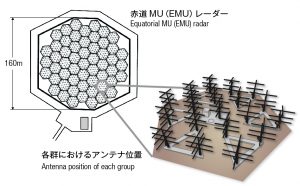
The Equatorial MU radar is planned at Northern side of EAR. The radar is as sensitive as the MU radar and can measure the entire lower/middle/upper atmosphere.


